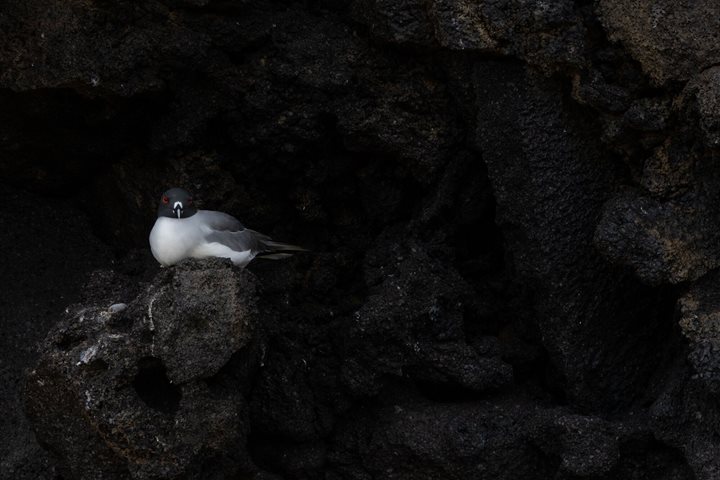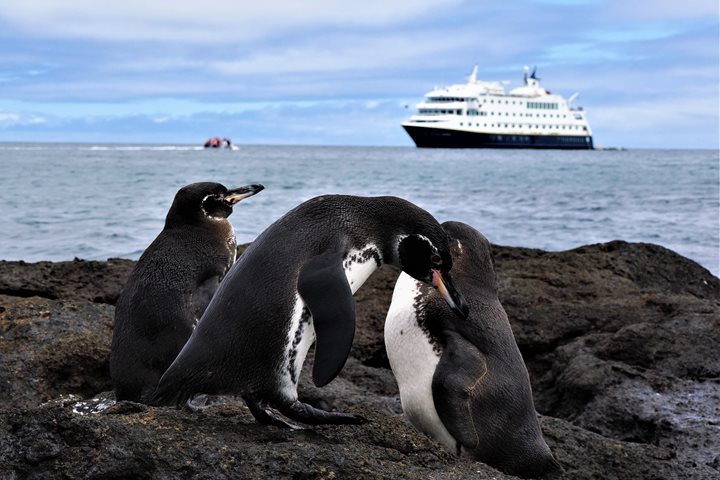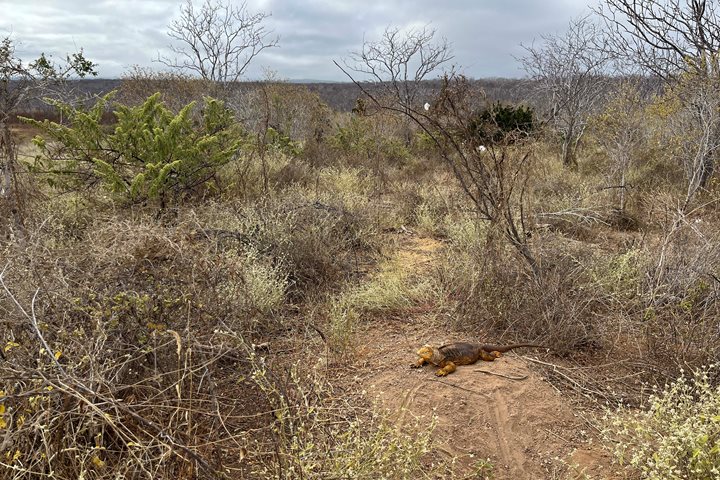Today’s exploration, our last of the week, took place on a small island in the right-hand corner of the Galapagos Archipelago, Genovesa Island. This island is home to many species of birds, including the red-footed and Nazca boobies, frigate birds, storm petrels, short-eared owls and four species of finches, including the large ground finch, the sharp-beaked ground finch, the cactus finch and the warbler finch. Today we started the morning with an early kayak outing along the edges of Genovesa for some bird watching, followed by a beautiful hike on the island after going up 82 feet along Prince Phillip’s Steps. The beauty of this island as you get to the top of the stairs is overwhelming; Nazca and red-footed boobies welcome you just 6 feet apart. Along the trail, close encounters continued in this breathtaking landscaping. After some snorkeling to look for Moorish idols and some more kayaking and paddle boarding, we visited Darwin Bay where more sea birds welcomed us on the beautiful, white coral beach. A fantastic day to end a very special expedition, an expedition in the Galapagos Islands.
- Daily Expedition Reports
- 10 Nov 2017
Genovesa Island, 11/10/2017, National Geographic Endeavour II
- Aboard the National Geographic Endeavour II
- Galápagos
Gianna Haro, Naturalist
Most of Gianna´s memories seem to be dreams, made on flawless white sandy beaches with black lava rock contours and gorgeous turquoise ocean waters. Most of it happened while barefoot, in an enchanting place that some people regard as an ideal natura...
Read MoreMark Clement, Video Chronicler
Mark Clement grew up in the foothills of the Adirondack Mountains in Upstate New York, where he developed a deep appreciation for wild places at a young age. Now living in the Green Mountains of Vermont, he has made a career out of capturing the beau...
Read MoreShare Report
Galápagos Aboard National Geographic Endeavour II
VIEW ITINERARYRelated Reports
10/6/2022
Read
National Geographic Endeavour II
Bartolome Island & Sombrero Chino
On National Geographic Endeavour II today, we explored Bartolome, home of a small colony of Galapagos penguins. Bartolome is one of the youngest islands, and it is located next to Santiago Island in the central part of the archipelago. After an amazing sunrise, we went ashore for a walk, and we were transported back to a time when the land was newly formed. We began our day by hiking to the top of a tuff cone known as the islet of Bartolome, named after the First Officer of The Beagle . Walking on this young island allowed us to understand the formation and volcanism of the Galapagos Islands. The rocks are a great way to understand the area and its geology. We spotted a few lava lizards and painted locusts, some of the very few animals on this island. As we reached the top, we had a great view. Our guests enjoyed the magnificence of Pinnacle Rock. After we visited one of the most iconic geological formations of the Galapagos, our breakfast was enhanced by dramatic views of the impressive volcanic landscape. We visited the beach near Pinnacle Rock, where we enjoyed how the sun made the sand sparkle due to a concentration of silica. Later, we went snorkeling along the channel between Santiago and Bartolome Islands. Many of our guests spotted whitetip reef sharks and very colorful parrotfish. The landscape was beautiful with lots of sea stars. We enjoyed the chance to be surrounded by Galapagos penguins and feel accepted as part of this environment. After a delicious Mexican lunch, we had lectures on the photography of reptiles and Darwin. Afterwards, we went to Chinese Hat Islet to snorkel from the Zodiacs. The area is home to a small colony of Galapagos penguins. In a sandy-bottomed, sheltered channel, our guests enjoyed swimming with whitetip reef sharks, rays, and many fish. It was a nice and sunny afternoon. After snorkeling, we had the chance to explore the unique, small volcano that formed an island in front of Santiago on a sunset Zodiac ride. After a spectacular day full of activities in the field, we returned on board. Every day in the Galapagos is an opportunity to reconnect with the beauty of nature through unbelievable encounters!
10/5/2022
Read
National Geographic Endeavour II
Cerro Dragón, Santa Cruz Island
Today, National Geographic Endeavour II visited Cerro Dragon, located on the north part of Santa Cruz Island. We found one of the largest colonies of land iguanas. During our hike, we spotted the iguanas all around the trail. Some basked on the vegetation, and others were active. We saw the zigzag head movement they use to protect their territory and impress females. An Ecuadorian buffet lunch was set up in the dining room. We started with the traditional ceviche and ended with tres leches for dessert! We enjoyed snorkeling and Zodiac rides. We observed wildlife all over the place, including spotted eagle rays, sharks, blue-footed boobies, great blue herons, marine iguanas, and hundreds of other animals. They all reminded us why the Galapagos is so special.









